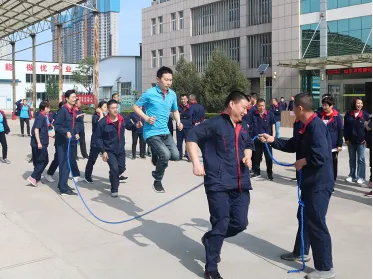Rope material
Synthetic fibers have different shapes that influence their characteristics and performance. Monofilaments are endless thick fibers with a stiff structure that offer very good abrasion resistance and low dirt take-up. Multifilaments are a bundle of thin fibers which are processed into twines before braiding a rope out of them. Most fibers follow this design which leads to high flexibility and tensile strength. Textured fibers are based on natural fibers and show a certain degree of disorder which gives the fibers good grip and high elasticity. The last type of fibers are Staple fibers which consist of spun pieces of short filaments. This construction gives the fiber excellent grip and soft handling.
Raw Material
Nylon (NY) / Polyamide (PA)
Polyamide or better known under its trade name Nylon, has high breaking load as well as high elongation. Preferably, it is used in products that are required to absorb shock loads like dynamic climbing ropes. The abrasion resistance of nylon is better in wet conditions than in dry conditions because it tends to take up water (up to 7%). Kept in wet conditions for too long, the material can become stiff. Another disadvantage compared to polyester is the lower resistance to UV-radiation in sunlight.
Polyester (PES)
Polyester is mainly used for static ropes because Polyester is characterized by good breaking loads and low stretch. This material offers both chemical and physical advantages such as UV resistance salt water resistance, and good abrasion strength in both dry and wet conditions. However, the dynamic energy absorption capacity is much lower than that of nylon ropes and therefore only to a limited extent suitable for types of use involving high impact forces.
Ultra High Molecular Weight Polyethylene (UHMWPE)
UHMWPE (also known as UHMPE or HMPE Dyneema®) is an extremely high strength fiber of ultra high molecular polyethylene. For the same weight it has 15 times the tensile strength of steel. Rope or slings made from this type of fiber shows very low elongation and tensile strength. If very high loads are being applied for a long period of time, UHMWPE fiber tends to creep. The rope then is irreversibly extending its length. At the same time, these robust fibers show excellent performance in terms of abrasion resistance and good UV-resistance.
Aramid (Aromatic Nylon)
Aramid fibers have an extremely high breaking load and show almost no stretch. On the other hand they are sensitive to UV-rays, bending over sharp edges, and abrasion. It is mainly used in places where high temperature resistance and abrasion is essential, for example on winches, in hot air balloon ropes or for canyoneering where the rope is nearly always in contact with rough stones.
Polypropylene (PP)
Due to its limited technical characteristics, polypropylene is only used for simple applications. PP is very light and even buoyant in water, that’s why it is used for water throwlines. Its abrasion resistance and temperature resistance are lower than those of most other fibers.
The Chemistry of Climbing Rope
-
- Rock climbing rope is a length of 60-80 meters of nylon rope. Climbing rope is dynamic which means that it is able to stretch to 6-7% of its original length. All dynamic climbing ropes have two parts: the sheath and the core. The sheath is the outer protective layer of the rope, made of tightly woven nylon fibers. The core of the rope the inner part of the rope making up about 70% of the ropes diameter. The core is made up of 10-15 braided nylon strings all packed tightly into the sheath. A standard 9.8mm dynamic rope has 11 braided nylon strings in its core. Nylon 6,6 is used to make dynamic rope because of its strong abrasion resistance and elasticity. The greater diameter of the rope is, the stronger that that rope will be. Many different companies manufacture climbing rope and all must pass the standard UIAA safety tests.
- I chose to research climbing rope because I am an avid rock climber and rope is possibly the most important factor in remaining safe while climbing large rock faces. My friends and I have all been saved by climbing ropes countless times. About .2% of all climbing deaths are due to total rope failure and I was curious as to why rock climbing rope was so strong and reliable.
- Climbing rope has affected my life by allowing me to be able to climb large rock faces outdoors safely. Climbing outside anywhere is what I and so many climbers like me live for and climbing rope is has made it possible for climbers like myself to try and accomplish many more challenging routes without worrying about falling to our deaths. Climbing rope has allowed me to become a better climber in the fields of endurance and concentration, because even if you do not die when you fall, it is still terrifying.
Composition of ...
A dynamic climbing rope is made of fibers from a polymer known as nylon 6,6. The chemical formula of nylon 6,6 is C12H22O2N2. The monomers of nylon 6,6 are hexamethylenediamine and adipic acid. Both of these monomers are organic compounds that are held together by an amide bond. These monomers form a long polymer chain that will eventually become large enough to be used as a fiber in the rope. Thousands of these fibers are twisted together to form a plain nylon string. Three of these strings are then braided together to make one of the 10-15 braided core strings. These strings are then packed tightly together and the sheath is woven around them. The sheath is made up of much flatter nylon strings accomplished by not twisting the the fibers together. These flat strings are then woven tightly together to form the protective layer around the core.
Main Chemicals, Compounds, Components
The two main compounds that combine to produce nylon 6,6 are hexamethylenediamine and adipic acid. The chemical formula of adipic acid is C6H10O4. This acid is produced by mixing cyclohexanol [(CH2)5CHOH] and cyclohexanone [(CH2)5CO] into an oil called ketone-alcohol oil. This oil is then oxidized with nitric acid [HNO3] to produce adipic acid. About 60% of all adipic acid produced is used for the synthesis of nylon 6,6. Hexamethylenediamine is the second monomer used in the production of the synthesis of nylon. The chemical formula of hexamethylenediamine is C6H16N2. This monomer is made by the hydrogenation of adiponitrile [(CH2)4(CN)2]. This bonds 4H2 to the adiponitrile forming hexamethylenediamine. This amine is produced only for the synthesis of nylon 6,6.
Chemistry's Role
The two valence electrons on the nitrogen in the hexamethylenediamine are given to the carbon of the adipic acid. The sudden negativity of the nitrogen attracts it to the carbon and the bonding of these two atoms pushes the hydrogen from the hexamethylenediamine and the hydroxide from the adipic acid out of the newly formed polymer. The hydroxide and hydrogen molecules will combine to produce a water molecule. The polymer is then held together by the attraction between the nitrogen and carbon. This bond is called an amide bond. The hexamethylene has the nitrogens and hydrogens on both sides of the molecule and the adipic acid has the carbons and the hydroxides on each side of the molecule. This means that the amide bond will continue to form between the monomers to form the polymer chain and producing water as a byproduct. It will keep forming a fiber for as long as there is hexamethylenediamine and adipic acid to be combined.
Background Research
The first dynamic climbing rope was developed in 1953 by Edelrid. It is dynamic because it stretches when a climber falls and puts it under pressure. This design of dynamic rope is called the kernmantle. The kern is the braided nylon core and the mantle is the the protective outer sheath of the rope. A 9.8mm diameter rope can take 5-10 completely static drops at 8kN. This is equivalent to about 1800 pounds being dropped from about 20 feet with absolutely no movement in the anchor point of the rope. All climbing ropes must pass these standard safety tests before they are to be distributed to climbers all over the world and are being used in all different types of rock climbing environments.
Natural Fear: Early Plant-Based Ropes
In the early days, “climbing ropes” were basically boat ropes. Braided cords of plant-based material were the norm.
Hemp was a common fiber choice, and climbers relied on hemp ropes as late as the 1950s. The plant is suitably robust (in tensile strength), but it’s cumbersome compared to modern rope materials and doesn’t stretch much. Its resistance to stretching limits its strength.
Almost all available evidence indicates risk tolerance was very different back in the day. Helmy and Fred Beckey’s second ascent of the South Face of Mt. Waddington (still a serious route today) in 1942 would undoubtedly have utilized hemp ropes.
Royal Robbins probably used hemp ropes on the first 5.9 in America, “Open Book,” in 1952. Climbers had first aided the route using wooden chocks (yes, 2x4s) the year before.
Robbins didn’t take any falls on the route, but similar ropes and gear held falls. Ignore the wannabe Ken Burns narration in this clip and hang with it for the first 20 seconds to watch a bonafide boat rope whipper.
Nylon Ropes Change the Game
In 1935, DuPont patented nylon, or synthetic polyamide, and changed the climbing world forever. The new fiber was mega-strong, stretchy, and lightweight — perfect for protecting climbers on the sharp end.
Nylon can exhibit different properties depending on its weave pattern. Some weaves, for instance, can make it pliable and stretchy; others can result in a durable, abrasion-resistant material.
That dual applicability led to the “kernmantel” structure, which defines the market today. Edelrid introduced the idea in 1953. The company is German, and in that language, “kern” means core, and “mantel” means sheath.
Simply put, a kernmantel rope’s core gives it stretch and strength. The sheath protects the core from the elements. Both parts consist of nylon fibers.
Nylon climbing ropes can let humans do unfathomable things. The late Dan Osman arguably pushed climbing ropes closer to their limit than any other human before or since. Tragically, he also broke the limit dying while jumping on a single rope.
Osman’s specialties included free-soloing and the world’s biggest rope swings. Skip to 3 minutes to watch the “Sky Pilot” rope jump 1,000 feet off Yosemite’s Leaning Tower.
How Climbing Rope is Made
GearJunkie found messaging with Edelrid’s rope manufacturing team similar to talking to any group of genius technicians: informative and often prohibitively technical.
In paraphrase, here’s how it all goes down.
Step One: Nylon to Filaments to Twisted Yarn
The first step in rope making is turning nylon into thin filaments. It’s melted, extruded, and then pulled out into strands. The strands combine to form nylon yarn, the primary material for any climbing rope.
Edelrid can achieve different rope characteristics by twisting the yarn together in up to five layers. It can also weave in materials like aramid and polyester to affect the rope’s elasticity.
To avoid curling and kinking, the manufacturer twists half the yarn to the left and half to the right. Edelrid’s technicians twist each nylon filament profusely — a meter-long segment contains between 100 and 140 twists.
After the twisting process, the yarn is ready for shrinking.
Step Two: Shrinkage
Properly shrunk yarn is integral to a rope’s dynamic qualities. Shrinking reduces its strength slightly, giving it the critical ability to stretch and rebound. Static ropes are made with unshrunk yarn.
Edelrid Head of Product Phillippe Westenberger said shrinking is critical in making a dynamic rope.
“Shrinking is the key process to give a rope its dynamic characteristics and make it a dynamic climbing rope. During this process, pressure, heat, and humidity shrink the fibers so that they can elongate later on again, for example, to catch a fall,” Westenberger explained.
“But not all shrinkage is the same, of course. Different materials and different intended rope characteristics demand different shrinking processes. Basically, performance then depends on the total time and how differently the three parameters are ramped up and down.”
Elongation and rebound are the main ingredients to a lead rope’s field performance. To visualize why, watch Sonnie Trotter take repeated 50-foot whippers off a classic Scottish trad route — apparently, all on the same cord.
To shrink the yarn, Edelrid weaves it into loose sheets and puts it into an industrial autoclave — essentially, a heavy-duty chemical reaction sauna.
Each raw fiber shrinks to about two-thirds of its original size and thickness.
Step Three: Braiding a Climbing Rope
After shrinking, Edelrid de-weaves the loose sheets and spins the sheath yarn onto bobbins. The bobbins sit aside until they’re ready to go into the braiding machine. The core yarn, meanwhile, gets its water-repellent treatment at this stage.
After that, the main event kicks off. Braiding machines work in a precise choreography: up to 48 bobbins can circulate, spin, and revolve around a single machine to make one rope. The bobbins mount on the machine’s “carriers.” Each one can carry a different yarn, and together, they spin the core and the sheath at the same time.
The general rule for sheath braiding is this: more carriers and thinner yarn make for the best rope characteristics. A rope’s sheath percentage increases with the number of carriers on the machine that braided it.
Intuitively, sheath percentage refers to how much of the rope is the sheath, measured by weight. Using thinner sheath yarn helps keep the rope’s weight down, and its surface slick.
“Generally, we can see a certain correlation of the higher the sheath percentage and the slicker the surface, the longer the rope will last,” said Westenberger.
He explained the utility in terms of handling and toughness. “Slickness of a rope decreases friction, so one can see the logical consequence of abrasion resistance. It also reduces rope drag when climbing and handling in belay devices.”
Like every parameter of rope construction, Edelrid controls the braiding process tightly. They set the speed the machine pulls the rope through itself, and they set the angle the machines braid the yarn and the tension of each thread.
The size of the hole machine pulls the rope through is the final variable and probably the most relatable to the everyday climber. It determines, of course, the rope’s diameter.
Step Four: Practicality
Edelrid makes about 1,000 m of a given rope during a production run.
Once it has a fully braided rope, it runs it through one of its various dry treatments. Most are PFC-based, but Eco Dry treatment uses paraffin, a type of wax.
Believe it or not, each meter of every Edelrid rope then passes through human hands before it leaves the factory floor. Experts feel for stiff spots or any other irregularities resulting from braiding.
Then another machine cuts the rope to length and stamps the middle mark. Workers finish the marks to make sure they’re distinct, and then manually melt and tape the ends. A final machine coils it for packaging.
Internal strength and break testing take place before Edelrid sends any rope to the International Climbing and Mountaineering Federation (UIAA) for certification.
How Strong Is Climbing Rope, Really?
The UIAA assumes a lot of responsibility (ethics and litigation) as the international certifying body for rope safety metrics. Consumers, by and large, purchase a lot of UIAA-rated climbing ropes around the world every day. Then, almost categorically, they go out into the world and abuse them.
All that considered, the organization generally plays it safe. Most field testing finds strength ratings reliable, and the “UIAA falls” ratings are thought to be conservative.
For entertaining, nonpretentious rope break testing that leverages professional lab technology, check out this clip from Hard is Easy. As a bonus, watch MC Ben rip an anchor out of his ceiling (in a somewhat improvised test from earlier days) about a minute in.
The team addresses plenty of field-applicable situations many climbers will be familiar with. “Should I cut the rope if I can squeeze a loop flat between my fingers? Should I worry about this fuzz?” And so on.
Tendon Ropes Factory Tour With … Wait, Who?
Curious to watch the whole modern rope-making process, one step at a time? Tour Tendon’s Bolatice, Czech Republic, facility with none other than “Tendon Top Employee Václav Nečesaný.”
Nečesaný knows what he’s talking about. And the results are in hand. If you take the video’s word for it, his ropes have helped world-class climbers pull off 5.15a/9a+ first ascents.










